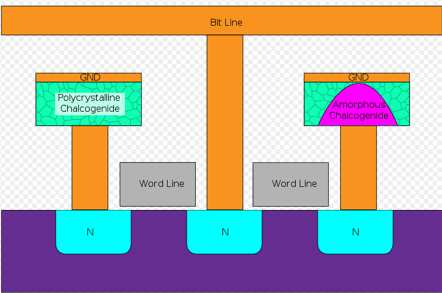PCM: flash killer or flash road kill?

The new silicon oxide nanocrystal memory isn't the only memory technology that could unseat NAND flash. Something called phase change memory (PCM) is shipping today.
PCM offers some key advantages over NAND:
- PCM retention time is independent of the number of write erase cycles. With NAND flash retention time drops with right to raise cycles.
- PCM can be read as often as you like. Read endurance does not decline with read write cycles.
- PCM read latency is almost as low as the RAM: 50-100 ns. Flash read latency is on the order of 15-50 µs.
- PCM endurance is better than 1 million write cycles. Most flash is from 10,000-100,000 write cycles.
- PCM may be written in byte size pieces, like DRAM. No flash translation layer for PCM.
How does it work? PCM uses a material – germanium-antimony-tellurium chalcogenide (GST) – whose resistance varies between its amorphous and crystalline states. The material is written to by applying a current flow of about half a milliamp. When the GST heats up it enters the low resistance crystalline state.
Here's a diagram of a PCM memory cell from Wikipedia:

GST is read by measuring the resistance at the memory location. Reads are nondestructive and can be repeated almost indefinitely. Writes take longer than reads but are still faster than NAND flash.
Available today PCM is currently manufactured by two vendors: Samsung and Numonyx, which was formed by the amalgamation of Intel's NOR flash with STMicroelectronics NAND businesses in 2008. Numonyx could not make it a go of it and was purchased by Micron, the Idaho DRAM and flash manufacturer, earlier this year.
There are few PCM parts today and it's expensive: about $8 for a 1 Gb part. Update: In response to a comment I went back and checked my source for the pricing and found I had misread it. Micron says it is sampling a 1 GB part on a 45 nm process, but it is not available for public sale. As such, the part price is likely much higher than I reported. I regret the error. End update. That's over 2x per bit as DRAM and, of course, is not nearly as dense.
However there are applications where PCM's byte level rewrites and long-term data retention make it attractive. It should first appear in mobile devices as dedicated embedded system storage.
Translation: you won't be using PCM to store MP3s anytime soon.
The Storage Bits take I spoke to the Micron PCM folks at the recent Flash Memory Summit in Santa Clara. They believe that with the Micron's financial heft and the Intel/Micron joint venture fab that PCM will start moving down the cost curve.
Much depends on whether flash hits the predicted capacity wall at 20 nm. Density predictions have a poor track record in storage. Huge capital investments often beat out promising but under-funded new technologies.
If flash doesn't scale down past 20 microns, PCM will be able to take up some of the slack. But it will take huge investments to scale manufacturing up and costs down. But it's good to know that we have another solid technical option for creating the next generation of nonvolatile memory.
Comments welcome, of course. Folks at the University of Illinois came up with a vertical nanowire PCM cells that reduce the reset current even further. Interesting!